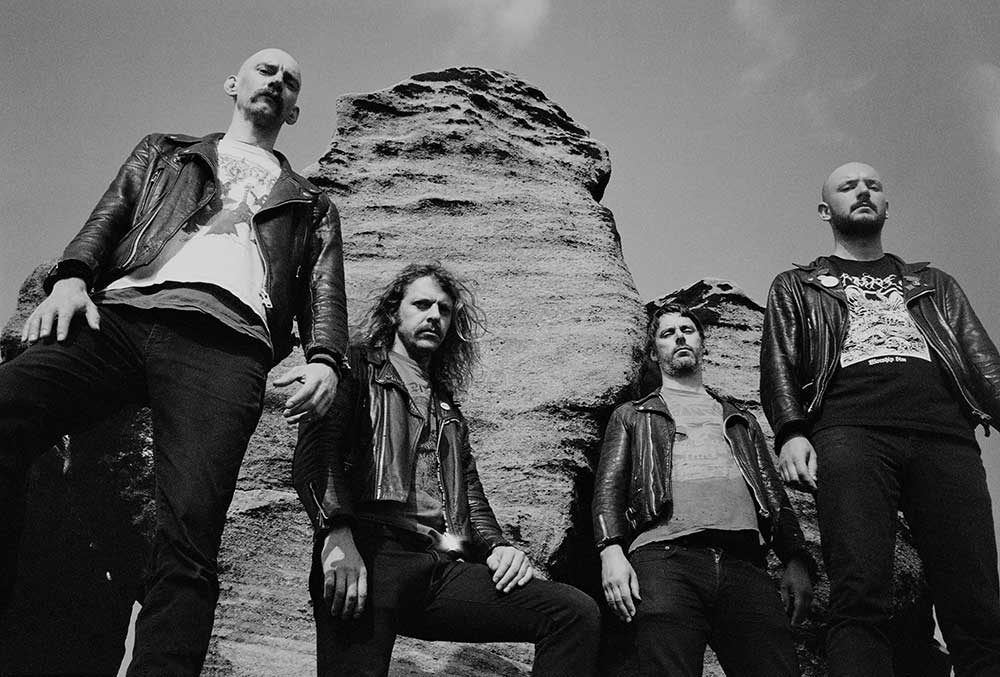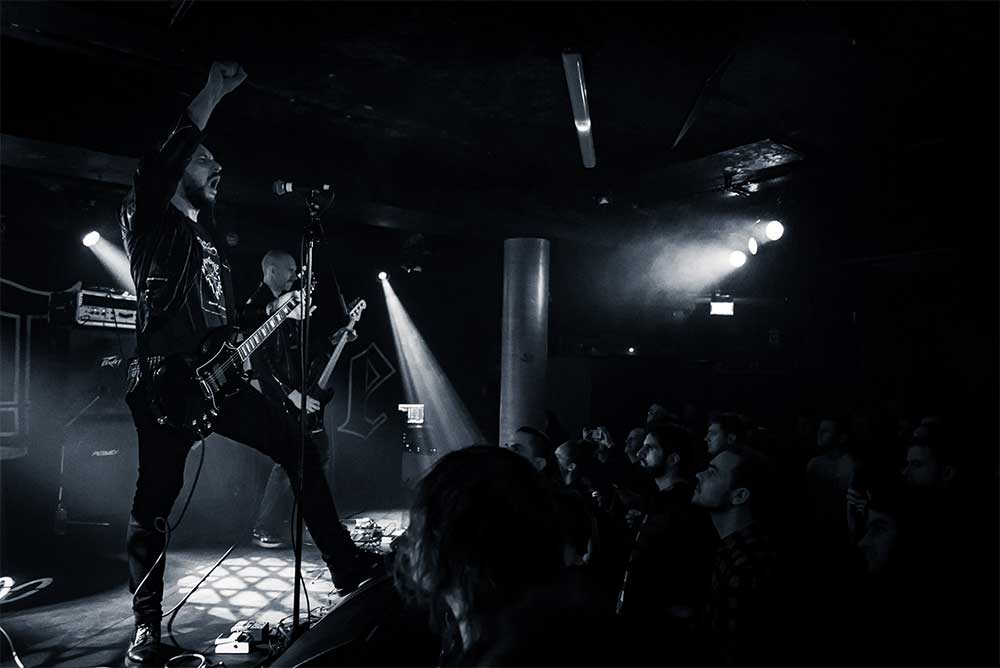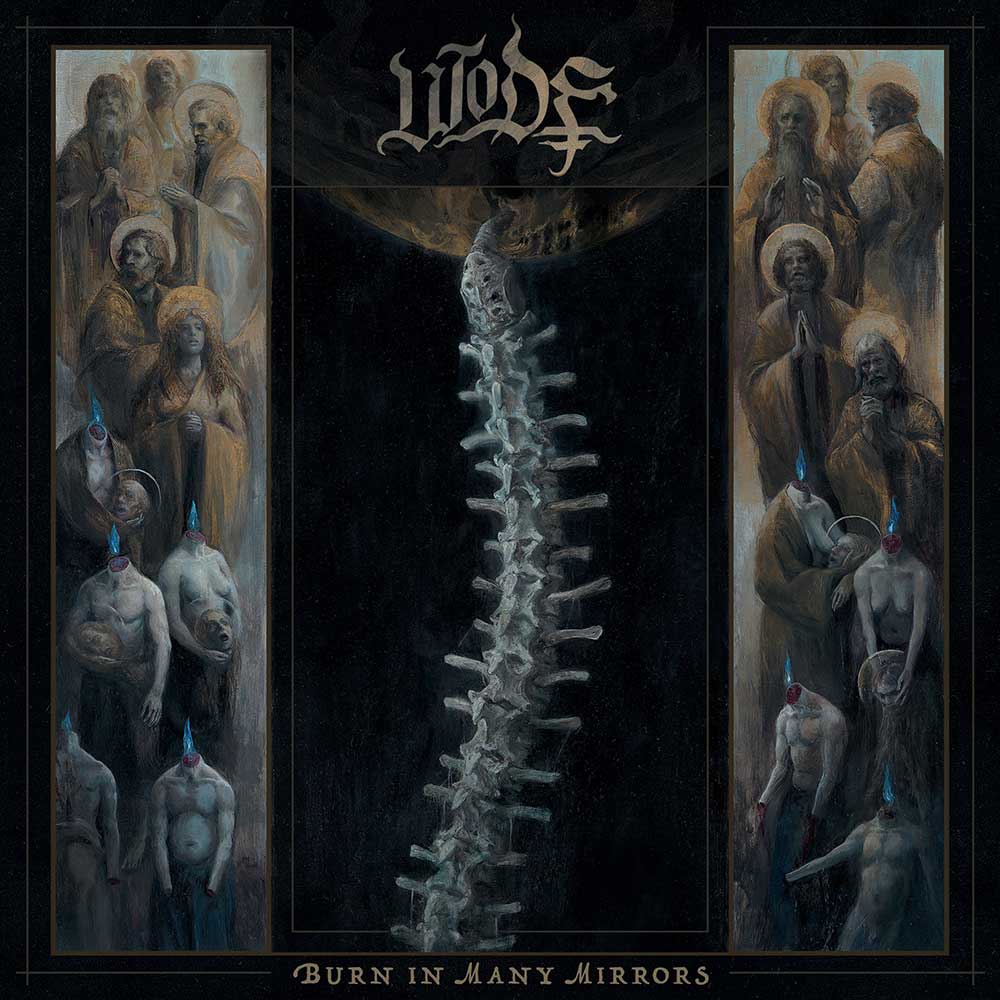Wode
2022-01-26
by Niklas Göransson
Mesmerised by fevers of madness – British black metal band Wode talk about the tumultuous creation of their latest album, Burn in Many Mirrors.
– “Burn in Many Mirrors” was written over the course of two years, says guitarist and vocalist Mike. This is the first album to feature our new guitarist, Dan, who joined from mine and Tim’s side-project AGGRESSIVE PERFECTOR in 2017. Tim and Ed also play in HEAVY SENTENCE, and it’s probably fair to say that some of the heavy metal elements of the other bands have fed into WODE somewhat. At the same time, I think “Burn in Many Mirrors” feels like the truest representation of who we are as a band and as people.
“Burn in Many Mirrors”, WODE’s third record, was released by 20 Buck Spin in April 2021. This is not quite what I expected from a modern British black metal band, with the album offering more of a filthy and violent MOTÖRHEAD feeling than the atmospheric soundscapes one has become accustomed to.
– To me, the Britishness and that punk-fuelled energy are one and the same. It harks back more to older bands like MOTÖRHEAD, VENOM, and AMEBIX – who combined punk and metal – rather than anything that’s currently happening in British underground metal. Our taste in black metal is pretty specific and tends to veer more towards the chaotic and riff-driven side of things; to a time before there was a codified ’sound’. We will always be influenced by bands that drew as much upon thrash, death, or doom as they did black metal, but who were all united through a shared morbid atmosphere. More than anything we try to write the type of music that we like and would want to hear, without being too constrained by genre classifications.
The subtle punkish feel is probably enhanced by the music’s energy – one which implies material that’s grown forth organically in a rehearsal place, as opposed to audio files being emailed back and forth.
– I suppose writing songs via file-sharing is useful if the band members are distanced from each other geographically, but I’m not sure it would ever work for us. It seems far too clinical and pre-determined, whereas we prefer to keep the rough edges. We’ve always operated in a fairly traditional manner, meeting up once a week at the rehearsal room to work on new material, play the old songs, and have a few beers. Tim or I will usually come up with some introductory riffs at home, but the bulk of our songwriting is shared between the four of us – often through improvisation. Playing together ‘in the moment’ always leads to songs taking unexpected twists and turns which would not have occurred if it was just one person writing by himself. We’re a tight-knit bunch, so it makes sense for the music to develop this way; most of us have been playing together for well over a decade, so it feels almost telepathic at times.

The album was recorded at Manchester’s Nø Studio. When WODE first set foot in there, March 2020, the world was a very different place from what it is now.
– The recordings started normally enough, although it was clear that trouble was brewing. A number of European countries had already gone into lockdown, but the full extent of the pandemic had yet to hit the UK. We’re so used to living under these circumstances now that I suppose we’ve become numb to it all, but at the time there was a very real sense of dread and paranoia in the air. We’d go to the pub after recording and each night there were fewer and fewer people there. By the end of the week, only those who really needed a drink were left. We finished recording for the week and made plans to continue soon after, but it wasn’t to be – the UK announced a full lockdown and the studio had to close its doors. We were left in limbo for an unspecified amount of time with an album only partially recorded; frustrating to say the least.
How much of a difference to the final result do you think this made?
– The intervening time between recording sessions actually proved quite fruitful for us. Thankfully, after the first session we had all the drums, some bass, and scratch guitar tracks down, so we were able to listen back to what we had and use the downtime to refine and improve our individual parts and come up with new ideas for leads and synths – all of which added an extra layer to the record. I spent a lot of that hiatus wandering through the urban sprawl and the wastelands on the city’s outskirts, which were now almost totally abandoned. These deserted zones felt strangely similar to the kind of ruined worlds with vanished populations that had provided an imagined setting for the album. My solitary walks led to a renewed focus on its themes and a number of changes to the lyrics.
A few months passed until WODE were finally able to return to Nø Studio. Unfortunately, the difficulties didn’t end there.
– The studio is located below street level, underneath one of the many dilapidated warehouses found in that part of the city. As it turned out, the owners had decided that now was the perfect time to dig up the concrete floor. The incessant noise of diggers and pneumatic drills heard between takes only added to the chaos. On the way to the studio one day, Joe Clayton – the engineer – came off his bike and ended up with a broken leg. Fair play to Joe: he started recording anyway, as it was unclear when we’d next be able to return, but the pain proved too much so we decided to call time for the day and drive him to the hospital. Also befalling us were glitches causing parts of tracks to be deleted, restricted studio access due to new guidelines, a near-completed mix we decided to scrap and begin again from scratch, and other personal misfortune. It definitely felt like a trial by fire, but we persevered and the results speak for themselves.

I was told that Nø Studio is located in Manchester’s red-light district. Having never had the pleasure myself, I read up on it online and came across an amazing depiction of Temperance Street, courtesy of Google Street View. The image – which can be seen here – shows a lady of the night in leopard-print tights, wanking off her customer with one hand and smoking a cigarette with the other. Pure class.
– That photo is great and perfectly encapsulates that part of the city, which I suppose is the ‘proper’ red-light district. It’s close to a legendary venue called the Star & Garter. The studio is located a bit further north, caught between the city centres of Manchester and Salford. It’s a grimy and lawless place: quiet during the day aside from the shops selling knock-off goods, but it comes alive at night when all the prostitutes, kerb crawlers, and criminal elements emerge. Strangeways – known as one of the most squalid and vermin-infested prisons in the country, once home to some of the region’s most notorious killers – looms large over the area, with its monolithic ventilation tower dominating the skyline. One of my earliest memories is of seeing the inmates who had escaped their cells and were protesting on the roof following the riots in 1990.
Do you think these surroundings influenced the album?
– We’re all products of our environment and I think the places we write and record in will always cast a shadow over the outcome, even subconsciously. Manchester can be a tough, violent, and chaotic place: traits I believe are reflected in our music. However, with this album we also wanted to capture that feeling through its concepts. Not in an obvious way, and I certainly wouldn’t describe our themes as modern or urban, but more in terms of an attitude and mood found in these decaying industrial parts of the city. Much like the music, the lyrical approach is fairly oblique, drawing from sources such as mythology, folklore, literature, dreams, and so on. Though the settings often relate to these twisted, imagined versions of our surroundings, albeit imbued with a sense of horror, religious eschatology, and subterranean menace.
Are all the settings in your lyrics fictional?
– There are a few real locations mentioned and they tend to be places which have been buried and lost to time and memory. Following early 20th-century excavations, Hanging Bridge – thought to be a place of execution – was accidentally discovered along with many human remains, but is now hidden again beneath the ever-expanding city. The ghost of the lost River Dene, culverted and flowing silently underneath the city for centuries, assumes the role of one of the infernal streams leading to Tartarus. And elsewhere, the burning hills and dark satanic mills of the surrounding region all contribute to the maelstrom. Manchester isn’t an obvious film location, but there is a great Hammer Productions film set here and its title sums things up quite well: Hell is a City.
Mancunian music has left a significant mark on other genres, but not so much metal. I browsed a list of metal bands from Manchester and barely recognised a single one besides WINTERFYLLETH, ATAVIST, and HECATE ENTHRONED. With this rather short list, it’s hard to pinpoint any common traits. In a black metal context, WODE are essentially on the opposite side of the spectrum from WINTERFYLLETH – in that they have this dystopian urban grit rather than any form of otherworldly nature-romanticism.
– WINTERFYLLETH are a bit out of the city I think, says drummer Tim, and their focus is very different to ours. There might be a common thread in that neither band puts on airs to seem more interesting; both are relatively down-to-earth, which might be unusual or perhaps even contrary to black metal. That could be because of Manchester’s industrial, working-class roots – it’s not a city where ‘pretension’ is tolerated. Growing up in the 90s, having hair that deviated from the regulation OASIS haircut would draw chants of ‘mosher’ and could land you in trouble. So, for all its claims of being a great musical city, it’s equally a place which is hostile to stuff that deviates from the norm. As much as I don’t subscribe to that mentality, it may well have left its mark in some way. Other cities are undoubtedly similar, but they don’t make a song and dance about their cultural heritage like Manchester.
What can you tell me about Manchester’s 90s underground metal scene?
– Bar HECATE ENTHRONED, who were from nearby, there wasn’t much black metal around Manchester that I knew of. There was more heavy doom stuff about, ATAVIST being the main example. And when I first started going to gigs, the local metal scene wasn’t very fertile. First contact, black metal wise, came from reading Terrorizer as a kid in the 90s and being amazed at how fanatical and extreme the genre was – but I wasn’t properly gripped by it until years later. I was initially disappointed that it wasn’t as heavy as the metal I’d been listening to up to that point, like SLAYER, SEPULTURA, and the 80s metal my dad weaned me on. I think it can take a bit of experience to fully ‘get’ the atmosphere.
Did it have much of an impact on you as a person?
– I think it does change you. There can be a tendency to want to embody the music and live by the black metal myth. That can be a dangerous game, but it can also be rewarding. For all its primitivism, black metal does have an esoteric side which can turn you on to different ideas and things you might not otherwise uncover. Although when that side gets overplayed, it can be a bit much. It’s still metal at the end of the day and although it does have meaning, it’s not something I enjoy in an overly cerebral way.

The visual representation of “Burn in Many Mirrors” – a painting by Argentinian artist Santiago Caruso – ties heavily into the thematic content which, in turn, drew inspiration from William Blake’s The Descent of Man into the Vale of Death.
– When developing the themes, says Mike, the main starting point came in the form of that William Blake illustration, which shows the spirits of the dead descending from the world above to the catacombs below. I find it useful to have a visual reference in mind when creating the world which an album inhabits – from that point you can expand outwards and combine many other elements and tie them all together within this familiar yet uncanny setting. Santiago is great to work with and a very singular artist. We initially gave him a few visual references, but his preference is to work more intuitively – painting based on his own interpretation of the lyrics – and we quickly realised that it’s probably best to trust an artist’s instincts with these things rather than trying to direct him.
The concept of “Burn in Many Mirrors” revolves around rapture, ancient powers unlocked in the depths, and a procession of the damned being led into the world below.
– In more symbolic terms, the world above represents the conscious mind whereas the world below is that of the psyche and its many regions. William Blake regarded human imagination as the essential quality by which the divine manifested itself in man, and the idea of visions taking form and volatile thoughts acquiring matter during the descent below is another central theme of the album. What followed was an unhealthy obsession with locating many of the hidden places I’d read about, as well as a fascination with other subterranean regions of the world. Robert Macfarlane’s book Underland – in which he travels to many of these places and uncovers the myths and memories associated with them – was a great resource at this time.
Katabasis, the descent into the underworld, is a concept explored not only by mythology, but also by influential thinkers such as Swiss psychoanalyst Carl Jung and Joseph Campbell – an American Professor of Literature who specialised in comparative studies of folklore and religion.
– Of course, the descent into the underworld is a paradigm which has existed in the lore of many different civilisations throughout history, not to mention well-trodden territory for metal bands. These persisting ideas could relate to some kind of shared ancient knowledge, archetypal ideas deriving from the ‘collective unconscious’, or just old-fashioned human fascination with the darker, unexplored regions of the world. Mythology is the art of storytelling and that’s the main focus for us here. Campbell‘s model of the Hero’s Journey is relevant to our story in terms of the spiritual death and transformation these characters must undergo as they venture below, but where it differs is that the protagonists in these myths always return to the surface. Theseus defeats the Minotaur and follows Ariadne’s thread to safety, Orpheus journeys into Hades but is able to return home, even Blake’s Vale of Death is only a temporary home before Hope illuminates a path to an eternal resting place. It’s a case of what goes down must come up, whereas the characters in our story are left to wander alone in the depths – which I suppose is more a reflection of the state of our world right now.



